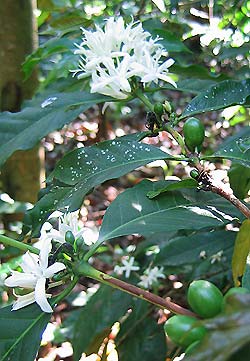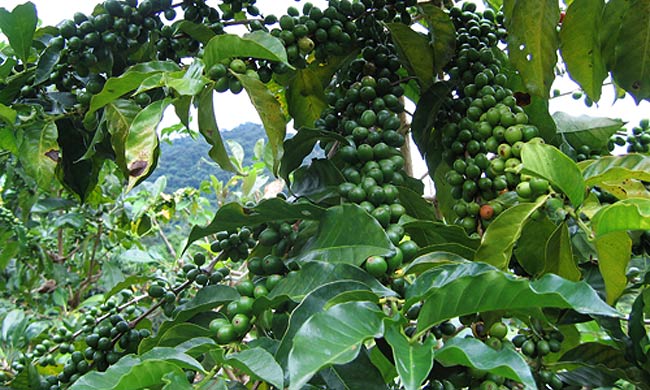**Coffee
Tree Coffea
arabica L.
Coffee trees are small, growing only to about 12 feet, but they are beautiful
with deep green shiny leaves and small fragrant white flowers. Even the berries
when ripe and red make the tree very appealing. It is a member of the same
family as ixora (see the I Page), but I think it is much more attractive. Coffee
beans
are usually harvested in late fall or early winter after they've turned fully
red. After the outer pulp is removed, the beans are allowed to ferment to more
easily remove the soft seed covering. The beans are then dried
in the sun and later winnowed in the wind to remove the dried skins. Roasting
coffee is the next phase and maybe the most interesting as it will dramatically
affect the flavor. Before being ground, coffee can be stored for several
months without losing its flavor.
Benefits:
Coffee is one of my true loves. I grew up from the
age of five drinking a cup of coffee with milk and sugar before leaving for school.
At the time, it was said that I would end up short and not so bright, never once
having had a breakfast until it was time for brunch. Well, I'm 5'10 and smart
enough, so sometimes the experts aren't so right. That's a good thing to remember
when reading about the marvels or dangers of any food. If you feel better after
enjoying a cup of coffee than you did before, that in itself tells you that it's
probably just fine to enjoy it. If you get jittery or have trouble sleeping,
that too is something your body is telling you and if you listen you'll do just
fine.
Coffee is now being touted as a wonderful
alternative to antidepressants by some recent researchers at the equally touted
Harvard University where some years ago its "renowned researchers" declared
that drinking coffee was the route to dying of cancer. Oops. Right now or right
then?
Thousands of research reports on coffee have been
published including two I remember well from decades ago, Harvard at the time
seemed to be saying that coffee would be the death of you while at the same
time Yale was preaching the curative benefits of coffee. At the time I wasn't
smart
enough to be looking at the funding sources for these research findings. Now
I am and it does make a difference in how I view what I read.
All that being said, the most recent
article on coffee I read by
Kerri-Ann Jennings, M.S., R.D., Associate Nutrition Editor at EatingWell
Magazine who had some thoughts on coffee. She made these points,
"1. It protects your heart: Moderate
coffee drinkers (1 to 3 cups/day) have lower rates of stroke than noncoffee drinkers,
an effect linked to coffee’s antioxidants. Coffee has more antioxidants
per serving than blueberries, making it the biggest source of antioxidants in
American diets. All those antioxidants may help suppress the damaging effect
of inflammation on arteries. Immediately after drinking it, coffee raises your
blood pressure and heart rate, but over the long term, it actually may lower
blood pressure as coffee’s antioxidants activate nitric oxide, widening
blood vessels.
2. It diverts diabetes: Those antioxidants
(chlorogenic acid and quinides, specifically) play another role: boosting your
cells’ sensitivity to insulin, which helps regulate blood sugar. In fact,
people who drink 4 or more cups of coffee each day may have a lower risk of
developing type 2 diabetes, according to some studies. Other studies have shown
that caffeine
can blunt the insulin-sensitivity boost, so if you do drink several cups a
day, try mixing in decaf occasionally.
3. Your liver loves it: OK, so the
research here is limited, but it looks like the more coffee people drink, the
lower their incidence of cirrhosis and other liver diseases. One analysis of
nine studies found that every 2-cup increase in daily coffee intake reduced liver
cancer risk by 43 percent. Again, it’s those antioxidants—chlorogenic
and caffeic acids—and caffeine that might prevent liver inflammation
and inhibit cancer cells.
4. It boosts your brain power: Drinking
between 1 and 5 cups a day (admittedly a big range) may help reduce risk of dementia
and Alzheimer’s disease, as well as Parkinson’s disease, studies
suggest. Those antioxidants may ward off brain cell damage and help the neurotransmitters
involved in cognitive function to work better.
5. It helps your headaches: And not
just the withdrawal headaches caused by skipping your daily dose of caffeine!
Studies show that 200 milligrams of caffeine—about the amount in 16 ounces
of brewed coffee—provides relief from headaches, including migraines. Exactly
how caffeine relieves headaches isn’t clear. But scientists do know that
caffeine boosts the activity of brain cells, causing surrounding blood vessels
to constrict. One theory is that this constriction helps to relieve the pressure
that causes the pain, says Robert Shapiro, M.D., Ph.D., associate professor
of neurology and director of the Headache Clinic at the University of Vermont
Medical
School."
Diseases: Coffee
is a major export crop for Guatemala. In the last couple of years the plants
have been devastated by a fungus called "coffee rust" which causes
leaves to fall, weakening the plants which then produce fewer and poorer quality
coffee beans.
Planting and Care: Coffee grows best in a semi
shady place with cool summery temperatures and lots of humidity
and rainfall or routine watering. I have found them very easy
to grow and very attractive as centerpiece plants in shady areas
of the garden where it is sometimes difficult to find something
special.
Text
and Photographs Copyrighted ©KO2008/2010 and ©GreenGardeningCookingCuring.com
2014
|



